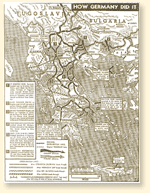

How Germany Did It
© The Hamilton Spectator, Reproduced with the permission
of the Hamilton Spectator. |
The Invasion of the Balkans: Yugoslavia, Greece and Crete, 1940-1941
On October 28, 1940, the Italian Duce, Benito Mussolini, invaded
northern Greece from Albania, which was at that time under Italian
control. Although greatly outnumbered, within a month the Greek army
had pushed the Italians back into Albania.
Adolf Hitler was unwilling to allow Italy, his major ally, to be
humiliated and he prepared to attack Greece, Britain's last European
ally. He had already got the cooperation of Hungary, Rumania and
Bulgaria, which were to the north and east of Greece, but Yugoslavia
lay between the German forces and Greece. A move against the
government in the Yugoslav capital of Belgrade provided the excuse
for the Germans to attack both Yugoslavia and Greece on April 6,
1941. Resistance in Yugoslavia quickly collapsed. The Greek armies,
reinforced by British, Australian and New Zealand forces, did not
last much longer. German soldiers raised the swastika flag over the
famous Acropolis in Athens on April 27.
Greek, British and British Commonwealth soldiers who escaped from
Greece moved to the nearby island of Crete, where they were joined
by fresh New Zealand, British and Australian forces. Hitler's men
hit them hard with a new form of German warfare, the
first major ssault ever attempted. General Kurt Student's
parachutists landed and surrounded the defenders on May 20. Although
the Germans suffered many losses, they had driven out
by the end of the month.
Flight Lieutenant V.C. Woodward, a Canadian flying a Hawker
Hurricane in No. 33 , , shot down as many as ten Italian
and German aircraft in the chaotic conditions of Greece and Crete.
He finished the campaign fighting on the ground in Crete armed only
with his pistol.
Related Newspaper Articles
- Text of the Italian Note to Greece
The New York Times, 29/10/1940
- 'We Fight A Common Foe' The King and Mr. Churchill Assure Leaders
of Greece
The Globe and Mail, 29/10/1940
- Report 175 000 British Troops Land in Greece
The Globe and Mail, 12/03/1941
- Hitler's Order of the Day
The New York Times, 07/04/1941
- Latest Moves in Balkans
The Globe and Mail, 10/03/1941
- British, Allies, in Final Stand Before Boches
The Hamilton Spectator, 28/04/1941
- How Germany Did It
The Hamilton Spectator, 03/05/1941
- Nazis Try to Invade an Island
The Globe and Mail, 21/05/1941
- 20 000 Air Troops Already Landed and More Pouring In
The Globe and Mail, 24/05/1941
- Tear Nazi Flag Off Acropolis
The Globe and Mail, 02/06/1941
|